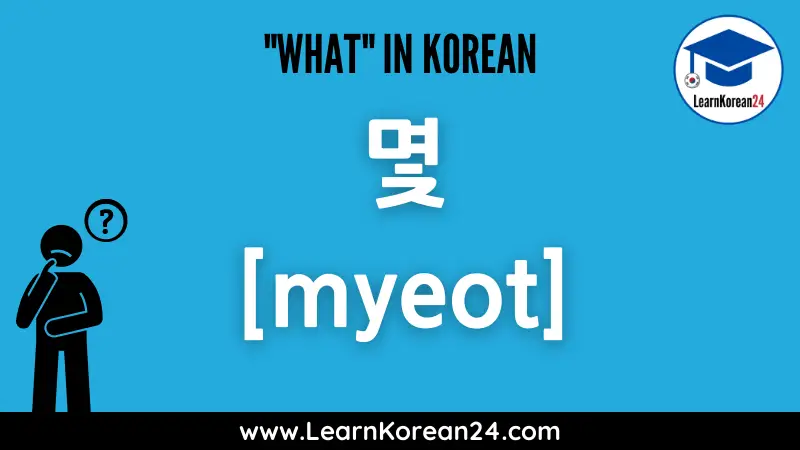The 6 Different Ways To Say ‘What’ In Korean
When learning Korean, most beginners learn that ‘what’ in Korean is 뭐 [mweo]. While this is correct, there are in fact many different ways to say ‘what’ in Korean. The particular word you use for ‘what’ in Korean depends on the particular sentence you are making. In English, when saying sentences like ‘What’s this?’, ‘What time is it?’, and ‘What do you do?’, the word for ‘what’ is the same. However, in Korean, the word for ‘what’ changes depending on the situation. To help you out, we have put together this list of the different ways to say ‘what’ in Korean.
‘What’ In Korean
So, how do you say ‘what’ in Korean? There are 6 different ways. These are 뭐 [mweo], 무슨 [mu-seun], 어떤 [eo-tteon], 몇 [myeot], 어떻게 [eo-tteo-ke], and 며칠 [myeo-chil].
The one you use depends on the situation you are using it in, so let’s take a look at some of the ways to use ‘What’ in Korean and some useful example sentences.
Examples Sentences
1. 뭐 [mweo]

The most common way to say ‘what’ in Korean is 뭐. 뭐 should never be followed by a noun. Let’s look at some example sentences with 뭐.
- 이름이 뭐예요? – (What’s your name?)
- 이거 뭐예요? – (What’s this?)
- 뭐 해요? – (What are you doing?)
- 뭐 좋아해요? – (What do you like?)
As you can see in these example sentences, 뭐 is not followed by any nouns. A common mistake beginner learners often make is to use 뭐 before a noun, such as 뭐책 (what book), 뭐 영화 (what movie), but this is wrong. When ‘what’ is followed by a noun in Korean, you must use 무슨.
2. 무슨 [mu-seun]

The next word for what’ in Korean is 무슨. 무슨 is used when ‘what’ is followed by a noun. For example, when saying ‘What movie do you like?’ (무슨 영화 좋아해요?) in Korean, the noun ‘movie’ follows ‘what’. And so, 무슨 must be used and not 뭐.
Let’s look at some example sentences with 무슨.
- 무슨 요일이에요? – (What day is it?)
- 무슨 뜻이에요? – (What does it mean?)
- 무슨 일 해요? – (What do you do?)
- 무슨 영화 좋아해요? – (What movie do you like?)
As you can see, in each sentence 무슨 is followed by a noun.
3. 어떤 [eo-tteon]

어떤 is similar to ‘What kind of’ in English. 어떤 should always be followed by a noun and cannot be used alone. Let’s look at some example sentences with 어떤.
- 어떤 일 해요? – (What kind of work do you do?)
- 어떤 영화 좋아해요? – (What kind of movies do you like?)
- 그 사람 어떤 사람이에요? – (What kind of person is he/she?)
- 어떤 옷을 찾으세요? – (What kind of clothes are you looking for?)
4. 몇 [myeot]

몇 literally means ‘how many’ but in some situations, 몇 translates as ‘what’. 몇 is always followed by a noun which is a counting unit. Let’s look at some example sentences with 몇.
- 몇 시예요? – (What time is it?)
- 몇 월이에요? – (What month is it?)
- 몇 년도예요? – (What year is it?)
- 몇 년생이에요? – (What year were you born in?)
- 몇 학년이에요? – (What grade are you in?)
- 몇 층이에요? – (What floor is it?)
5. 어떻게 [eo-tteo-ke]

어떻게 literally means ‘how’, but in many Korean sentences it functions as ‘what’. 어떻게 is always followed by a verb. Let’s look at some example sentences with 어떻게.
- 성함이 어떻게 되세요? – (What’s your name?)
- 근무 시간이 어떻게 돼요? – (What hours do you work?)
- 어떻게 생각해요? – (What do you think?)
- 그 사람 어떻게 생겼어요? – (What does he/she look like?)
6. 며칠 [myeo-chil]

We use 며칠 to ask ‘what date’ in Korean. Many Korean learners assume that 며칠 is 몇 (how many) + 일 (day) but this is incorrect. 며칠 comes from the old Korean word 며칟날 which literally means ‘what date’. Let’s look at some example sentences with 며칠.
- 오늘 며칠이에요? What date is it today?
- 생일이 며칠이에요? What date is your birthday?
- 며칠에 출발해요? What date are you leaving?
며칠 can also function as ‘how’ when talking about ‘how many days’.
Are you ready to get serious about learning Korean? Start our 100% FREE online Korean language course today!

